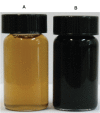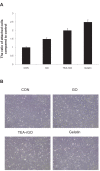Green chemistry approach for the synthesis of biocompatible graphene
- PMID: 23940417
- PMCID: PMC3736970
- DOI: 10.2147/IJN.S45174
Green chemistry approach for the synthesis of biocompatible graphene
Abstract
Background: Graphene is a single-atom thick, two-dimensional sheet of hexagonally arranged carbon atoms isolated from its three-dimensional parent material, graphite. One of the most common methods for preparation of graphene is chemical exfoliation of graphite using powerful oxidizing agents. Generally, graphene is synthesized through deoxygenation of graphene oxide (GO) by using hydrazine, which is one of the most widespread and strongest reducing agents. Due to the high toxicity of hydrazine, it is not a promising reducing agent in large-scale production of graphene; therefore, this study focused on a green or sustainable synthesis of graphene and the biocompatibility of graphene in primary mouse embryonic fibroblast cells (PMEFs).
Methods: Here, we demonstrated a simple, rapid, and green chemistry approach for the synthesis of reduced GO (rGO) from GO using triethylamine (TEA) as a reducing agent and stabilizing agent. The obtained TEA reduced GO (TEA-rGO) was characterized by ultraviolet (UV)-visible absorption spectroscopy, X-ray diffraction (XRD), particle size dynamic light scattering (DLS), scanning electron microscopy (SEM), Raman spectroscopy, and atomic force microscopy (AFM).
Results: The transition of graphene oxide to graphene was confirmed by UV-visible spectroscopy. XRD and SEM were used to investigate the crystallinity of graphene and the surface morphologies of prepared graphene respectively. The formation of defects further supports the functionalization of graphene as indicated in the Raman spectrum of TEA-rGO. Surface morphology and the thickness of the GO and TEA-rGO were analyzed using AFM. The presented results suggest that TEA-rGO shows significantly more biocompatibility with PMEFs cells than GO.
Conclusion: This is the first report about using TEA as a reducing as well as a stabilizing agent for the preparation of biocompatible graphene. The proposed safe and green method offers substitute routes for large-scale production of graphene for several biomedical applications.
Keywords: Raman spectroscopy; atomic force microscopy; graphene; graphene oxide; triethylamine; ultraviolet; visible spectroscopy.
Figures











Similar articles
-
Ginkgo biloba: a natural reducing agent for the synthesis of cytocompatible graphene.Int J Nanomedicine. 2014;9:363-77. doi: 10.2147/IJN.S53538. Epub 2014 Jan 7. Int J Nanomedicine. 2014. PMID: 24453487 Free PMC article.
-
Green synthesis of graphene and its cytotoxic effects in human breast cancer cells.Int J Nanomedicine. 2013;8:1015-27. doi: 10.2147/IJN.S42047. Epub 2013 Mar 10. Int J Nanomedicine. 2013. PMID: 23687445 Free PMC article.
-
Humanin: a novel functional molecule for the green synthesis of graphene.Colloids Surf B Biointerfaces. 2013 Nov 1;111:376-83. doi: 10.1016/j.colsurfb.2013.06.018. Epub 2013 Jun 24. Colloids Surf B Biointerfaces. 2013. PMID: 23850746
-
Bio-reduction of Graphene Oxide: Catalytic Applications of (Reduced) GO in Organic Synthesis.Curr Org Synth. 2020;17(3):164-191. doi: 10.2174/1570179417666200115110403. Curr Org Synth. 2020. PMID: 32538718 Review.
-
Biological interactions of graphene-family nanomaterials: an interdisciplinary review.Chem Res Toxicol. 2012 Jan 13;25(1):15-34. doi: 10.1021/tx200339h. Epub 2011 Oct 21. Chem Res Toxicol. 2012. PMID: 21954945 Free PMC article. Review.
Cited by
-
Current Overview of Metal Nanoparticles' Synthesis, Characterization, and Biomedical Applications, with a Focus on Silver and Gold Nanoparticles.Pharmaceuticals (Basel). 2023 Oct 4;16(10):1410. doi: 10.3390/ph16101410. Pharmaceuticals (Basel). 2023. PMID: 37895881 Free PMC article. Review.
-
Synergistic antibacterial activity of surfactant free Ag-GO nanocomposites.Sci Rep. 2021 Jan 8;11(1):196. doi: 10.1038/s41598-020-80013-w. Sci Rep. 2021. PMID: 33420190 Free PMC article.
-
Biomedical Waste Management by Using Nanophotocatalysts: The Need for New Options.Materials (Basel). 2020 Aug 9;13(16):3511. doi: 10.3390/ma13163511. Materials (Basel). 2020. PMID: 32784877 Free PMC article. Review.
-
Enhanced Photocatalytic Activity and Stability in Hydrogen Evolution of Mo6 Iodide Clusters Supported on Graphene Oxide.Nanomaterials (Basel). 2020 Jun 28;10(7):1259. doi: 10.3390/nano10071259. Nanomaterials (Basel). 2020. PMID: 32605229 Free PMC article.
-
Novel biomolecule lycopene-reduced graphene oxide-silver nanoparticle enhances apoptotic potential of trichostatin A in human ovarian cancer cells (SKOV3).Int J Nanomedicine. 2017 Oct 13;12:7551-7575. doi: 10.2147/IJN.S144161. eCollection 2017. Int J Nanomedicine. 2017. PMID: 29075115 Free PMC article.
References
-
- Novoselov KS, Geim AK, Morozov SV, et al. Electric field effect in atomically thin carbon films. Science. 2004;306(5696):666–669. - PubMed
-
- Geim AK, Novoselov KS. The rise of graphene. Nat Mater. 2007;6(3):183–191. - PubMed
-
- Rao CN, Sood AK, Subrahmanyam KS, Govindaraj A. Graphene: the new two-dimensional nanomaterial. Angew Chem Int Ed Engl. 2009;48(42):7752–7777. - PubMed
-
- Dikin DA, Stankovich S, Zimney EJ, et al. Preparation and characterization of graphene oxide paper. Nature. 2007;448(7152):457–460. - PubMed
-
- Dreyer DR, Park S, Bielawski C, Ruoff RS. The chemistry of graphene oxide. Chem Soc Rev. 2009;39(1):228–240. - PubMed
Publication types
MeSH terms
Substances
LinkOut - more resources
Full Text Sources
Other Literature Sources
Miscellaneous

